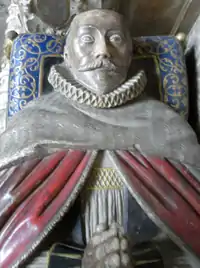Valentine Cary
Valentine Cary (died 1626) (alias Carey, erroneously Carew[1]), was an English clergyman, who became Bishop of Exeter.



Origins
His origins are uncertain. He was born in about 1570 and is believed to have been an illegitimate son of Henry Carey, 1st Baron Hunsdon (1526–1596),[2] due to the known fact that he was born at Berwick-upon-Tweed and at about the time when Lord Hunsdon was stationed there in connection with his military duties.[3] This supposition therefore makes him an illegitimate brother of George Carey, 2nd Baron Hunsdon and of John Carey, 3rd Baron Hunsdon, whose son Henry Carey, 1st Earl of Dover, (and 1st Viscount Rochefort, 4th Baron Hunsdon) was the Bishop's patron by whose direct influence he was created Bishop of Exeter.[4] In his will he names the 4th Baron's daughter Judith Carey as his god-daughter, and bequeathed to Sir John Carey, the 4th Baron's son and heir apparent, the sum of £10 for a mourning ring.[5] He is known to have used the arms of the Carey family of Cockington and Clovelly in Devon (Argent, on a bend sable three roses of the field), of which the Barons Hunsdon were a junior branch, but added a bordure compony.[6]
Career
He was a graduate of Christ's College, Cambridge,[7] and in 1591 was a Fellow of St John's College, Cambridge.[8]
A pluralist, Cary was vicar of East Tilbury in 1603, rector at Great Parndon 1606 to 1616, and was vicar of Epping Upland from 1607 to 1609. He was also rector of Orsett and Toft from 1610.[9][10][11]
In 1609/10, through the influence of his supposed half-brother John Carey, 3rd Baron Hunsdon (d.1617),[12] he became Master of Christ's College, where he had been a Fellow from 1597 to 1600.[13][14] The election was bitterly contested, by the Puritan element. Cary was backed by the Lord Chancellor, Baron Ellesmere.[15] It led immediately to a confrontation between Cary and William Ames, who refused to wear the surplice, and who left Cambridge almost immediately. It also led Cary to be suspicious of Joseph Mede, who was to be one of Christ's best-known Fellows.[16]
He was later Dean of St. Paul's. In 1621 he was appointed Bishop of Exeter.
Death and burial
He died at his London townhouse in Drury Lane and was buried in St Paul's Cathedral, as he requested in his will should he die in London.[19] Any monument he may have had in St Paul's did not survive the Great Fire of London of 1666. His elaborate monument with effigy does however survive in Exeter Cathedral.[20]
Notes and references
Citations
- The Carew family is a separate family prominent in Devon
- "Carew or Cary, Valentine (CRW585V)". A Cambridge Alumni Database. University of Cambridge. However "The Herald and Genealogist", p.385, supposes him to have been "the third son of an illegitimate child", based upon his use of an heraldic mullet for difference in his arms
- The Herald and Genealogist, Volume 4, 1867, pp.385–8, Valentine Carey, DD, Bishop of Exeter
- Herald and Genealogist, p.385
- Herald and Genealogist, p.388
- Herald and Genealogist, p.385; Bishops are known to have added bordures to their paternal arms, for example as seen on the monument in Exeter Cathedral to Walter de Stapledon (d.1326), Bishop of Exeter
- "Carew or Cary, Valentine (CRW585V)". A Cambridge Alumni Database. University of Cambridge.
- "Valentine Carey (D. 1626) | StJohns".
- Concise Dictionary of National Biography
- "Parishes: Great Parndon | British History Online".
- "Epping: Churches, schools and charities | British History Online".
- Herald and Genealogist, p.386
- "Christ's College - College Life - Former Masters of Christ's College". Archived from the original on 11 February 2012. Retrieved 6 November 2008.
- "The colleges and halls: Christ's | British History Online".
- "Calendar of State Papers Domestic: James I | British History Online".
- Stephen Bondos-Greene, The End of an Era: Cambridge Puritanism and the Christ's College Election of 1609, The Historical Journal 25 no. 1 (1982).
- Tracy & Ragnow 2004, p. 211. First, King James's appointment of series of bishops later labeled Arminian after the leading Dutch Remonstrant theologian - [...] Valentine Carey (1621) - created on the bench of bishops a vigorous minority who had no sympathy for old-fashioned orthodox Calvinism [...].
- Houston 2014, p. 71. [Neile] did a lot to further the episcopal careers of Arminians like John Buckeridge, Gilbert Overall, William Barlow, John Howson and Valentine Carey.
- Herald and Genealogist, p.387
- "Archived copy". Archived from the original on 8 January 2017. Retrieved 2 March 2022.
{{cite web}}: CS1 maint: archived copy as title (link)
Sources
- Houston, S. J. (2014). James I. New York: Routledge.
- Tracy, James D.; Ragnow, Marguerite (2004). Religion and the Early Modern State: Views from China, Russia, and the West. Cambridge: Cambridge University Press.
